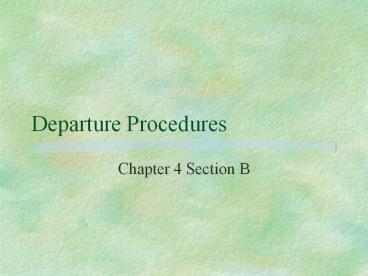Departure Procedures - PowerPoint PPT Presentation
1 / 14
Title:
Departure Procedures
Description:
... IFR Departure Procedures Standard 200 /nm climb gradient 35 at end of runway 400 HAA before ... What is the minimum rate climb per NM to 9,000 feet ... – PowerPoint PPT presentation
Number of Views:134
Avg rating:3.0/5.0
Title: Departure Procedures
1
Departure Procedures
- Chapter 4 Section B
2
Takeoff Minimums
- Prevailing visibility
- Runway visibility value (RVV)
- Runway Visual Range (RVR)
3
IFR Departure Procedures
- Standard
- 200/nm climb gradient
- 35 at end of runway
- 400 HAA before turning
- Nonstandard
- Avoidance by climb or heading
- denoted by T on IAP
- description in front of IAPs
4
Rate of Climb Table
Climb Rate Ft. per NM
Ground Speed
5
Departure Procedures(general)
- Climb and descents
- What is meant by resume own navigation?
- Radar contact means only that AC is on screen.
6
Departure Procedures(general)
- If VFR conditions, make gentle turns to scan for
traffic
7
(Refer to figure 85.) What route should you take
if cleared for the Washoe Two Departure and your
assigned route is V6? A. Climb on the LOC south
course to WAGGE, turn left and fly direct to FMG
VORTAC. If at 10,000 turn left and proceed on FMG
R 241 if not at 10,000 enter depicted holding
pattern and climb to 10,000 before proceeding on
FMG R 241. B. Climb on the LOC south course to
cross WAGGE at 9,000, turn left and fly direct to
FMG VORTAC and cross at or above 10,000, and
proceed on FMG R 241. C. Climb on the LOC south
course to WAGGE where you will be vectored to
V6.
8
(Refer to figure 85.) What route should you take
if cleared for the Washoe Two Departure and your
assigned route is V6? C. Climb on the LOC south
course to WAGGE where you will be vectored to
V6.
9
(Refer to figure 85.) What procedure should be
followed if communications are lost before
reaching 9,000 feet? A. At 9,000, turn left
direct to FMG VORTAC, then via assigned route if
at proper altitude if not, climb in holding
pattern until reaching the proper altitude. B.
Continue climb to WAGGE INT, turn left direct to
FMG VORTAC, then if at or above MCA, proceed on
assigned route if not, continue climb in holding
pattern until at the proper altitude. C.
Continue climb on LOC course to cross WAGGE INT
at or above 9,000, turn left direct to FMG VORTAC
to cross at 10,000 or above, and continue on
assigned course.
10
(Refer to figure 85.) What procedure should be
followed if communications are lost before
reaching 9,000 feet? B. Continue climb to WAGGE
INT, turn left direct to FMG VORTAC, then if at
or above MCA, proceed on assigned route if not,
continue climb in holding pattern until at the
proper altitude.
11
4.4.4.9.1.A.1 J16 (Refer to figure
85.) What is the minimum rate climb per NM to
9,000 feet required for the WASH2 WAGGE
Departure? A. 400 feet. B. 750 feet. C.
875 feet.
12
4.4.4.9.1.A.1 J16 (Refer to figure
85.) What is the minimum rate climb per NM to
9,000 feet required for the WASH2 WAGGE
Departure? A. 400 feet.
13
4.4.4.9.2.A.1 J16 (Refer to figure
85.) Of the following, which is the minimum
acceptable rate of climb (feet per minute) to
9,000 feet required for the WASH2 WAGGE departure
at a GS of 150 knots? A. 750 feet per
minute. B. 825 feet per minute. C. 1,000 feet
per minute.
14
4.4.4.9.2.A.1 J16 (Refer to figure
85.) Of the following, which is the minimum
acceptable rate of climb (feet per minute) to
9,000 feet required for the WASH2 WAGGE departure
at a GS of 150 knots? C. 1,000 feet per
minute.































